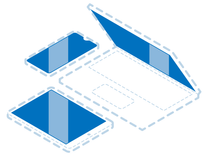Introduction
We’ve all seen videos from the VHS time frame, when scan lines dominated video content. Even high quality displays were fuzzy at best. But no one wants to play games on their iPhone when the screen looks like it's in prison stripes. Here are some steps to get your display back to normal.
The Basics
Before undertaking any of the more time consuming solutions below, these are a few fundamentals to get you started.
- Restart your phone. This might clear any minor hiccups. A force restart can be used instead, especially if your phone is experiencing other symptoms.
- Using any new accessories? Screen protectors can trap debris, or may introduce visual differences. Verify that the lines disappear if your screen is off.
Causes
It is rare for an iPhone to develop issues producing an image because of a software issue. But it is certainly possible. Bugs in apps, or the operating system could cause this sort of problem.
- Check to see if the issue is present in other applications. If not, close the affected app and try to reproduce the issue. If it occurs again, update that app.
- Update your phone if it seems to occur in multiple applications, or on the home screen.
- Resetting your device is unlikely to resolve this issue, but it will rule out software as a cause. Back up your data and process the reset through iTunes so a brand new, up to date copy of the software is pulled straight from Apple.
Especially after a hefty drop, or after repair, the connection between the board and the display may not be solid.
- Break out the toolset, open up your phone, and reseat any display related connectors.
- Use compressed air or isopropyl alcohol and a cotton swab to remove any dust or other debris from within the connector.
Display information is transmitted through several electrical lines both from the screen to to logic board and on the display itself. Damage to specific lines can lead to missing data bout parts of the display. This can manifest as colored or blank lines.
- Check internal cables for signs of tears or other damage. Corners or folds are especially susceptible.
- Use the iFixit Display Replacement Guide for your iPhone to determine which cables are related to screen function.
- If you have replaced the display recently, check your work. Tears can happen without the phone being opened but are more likely when the screen has been removed.
- If any damage is found, replace your display.
Although most display failures seem obvious, even without visible damage, this is not always the case. Display failures can occur as a result of manufacturing fault, or imperceptible damage.
- Look closely at your display for signs of break. Changing your viewing angle may help catch small hairline cracks.
- Lines tend to originate from the site of the damage. Pay close attention to these areas.
- Use a paperclip to eject the SIM tray. Shine a light into the slot to check the liquid contact indicator—it will be pink or red if it has touched liquid!
- Green or purple lines on the display are common on newer iPhone displays. This is indicative of an electrical issue within the screen.
- Green pixels in Apple's OLED displays are all aligned vertically. Red and blue pixels alternate in the adjacent pixel columns. Minor damage can break specific lines resulting in green or purple lines.
- This issue can sometimes be repaired with a laser machine, but due to the cost and accessibility, a replacement screen is a better bet.
- If you have replaced the display recently, be extra mindful. Inspect any of the components on the back of the display. Damage to these chips can also impact image quality.
- If any of the above types of damage are discovered, or software fixes have not made a difference, replace the display.

Find compatible replacement parts for your Apple iPhone. All parts and fix kits are backed by the iFixit Quality Guarantee.
The logic board is the hub for the vast majority of an iPhone's functionality. Any number of the small components on the board may have failed or become damaged, and is a safe assumption of cause if nothing else on this page has worked.
- Check for obvious signs of a board issue - burned or cracked components, liquid residue, corrosion, or bend. If there are signs of liquid the iPhone Liquid Damage Guide might help.
- Replacing the logic board is often the most practical solution for a DIYer whose board has failed.
- If you’re feeling especially curious, the tiny bits and chips on the board can be repaired with microsoldering. It is an art unto itself, but a worthy endeavor for those who are adventurous. Interested? Check out this intro! Jessa’s YouTube channel is also fantastic and has loads of real time repairs. If you can't do this sort of repair yourself, you may be able to find a local shop who can!

- 1 hourModerate
You're seeing solutions for Apple iPhone. Select your model to find parts for your device.







